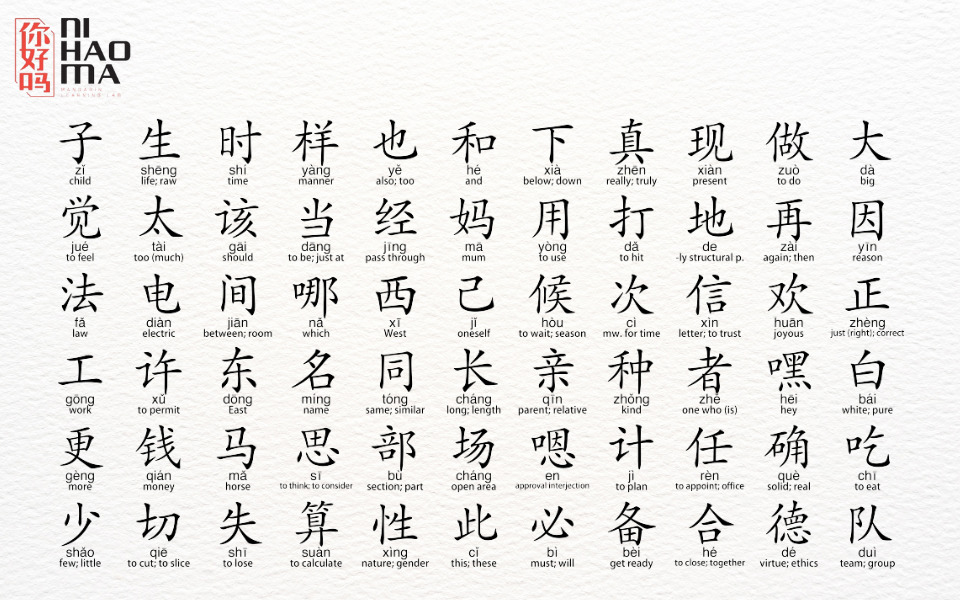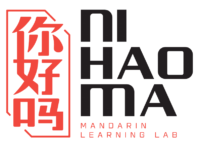Chinese is currently one of the most widely used languages in the world. So, is Chinese hard to learn? In this article, Ni Hao Ma will explore the reasons why Chinese is considered “challenging” and introduce methods that can help you master the language more effectively.
Is Chinese Hard to Learn?
Although Chinese is one of the most popular languages globally, it is also regarded as one of the most difficult languages to learn. For both Vietnamese speakers and native English speakers, mastering Chinese can present numerous challenges.
The Complexity of the Chinese Writing System
One of the greatest challenges in learning Chinese is its writing system. Unlike languages that use the Latin alphabet, Chinese employs logograms, requiring learners to memorize thousands of different characters. Each character in Chinese represents a specific meaning, and its form does not follow any fixed rules like the Latin letters.

In contrast to Vietnamese, where words are formed by combining letters, Chinese characters are composed of radicals. There are a total of 214 radicals in Chinese, some of which are very common and appear in many different characters. By recognizing radicals, you can often infer part of a character’s meaning.
For example, the radical 水 (with its variant 氵) – known as the “water” radical – commonly appears in characters related to water, such as:
- 江 (jiāng) – river
- 河 (hé) – river
- 海 (hǎi) – sea
Distinct Grammatical Structures
Chinese grammar exhibits several differences compared to both Vietnamese and English, which can easily lead to confusion among learners. Notable among these are differences in sentence structure, word order, and various semantic elements that demand careful attention during communication.
For instance, consider the following example:
- English: “I bought a book yesterday.”
- Chinese: 我昨天买了一本书. (Wǒ zuótiān mǎi le yī běn shū.)
- Vietnamese: “Tôi đã mua một quyển sách hôm qua.”
In Chinese, the time adverb 昨天 (zuótiān – yesterday) is typically placed before the verb, whereas in English and Vietnamese, the time adverb usually appears at the end or the beginning of the sentence.

Another distinct feature of Chinese is the use of measure words when counting or describing nouns. In English, we say “a piece of paper” or “a cup of coffee,” but such classifiers are far more prevalent and indispensable in Chinese. Chinese measure words are typically used alongside specific nouns and cannot be omitted. For example:
- 一本书 (Yī běn shū) – one book (with 本 as the measure word for books)
- 一只猫 (Yī zhī māo) – one cat (with 只 as the measure word for animals)
- 一辆车 (Yī liàng chē) – one car (with 辆 as the measure word for vehicles)
For Vietnamese speakers and native English speakers alike, remembering the appropriate measure words for each noun is a major challenge, as there is no fixed rule; they must be memorized and practiced.
The Diversity of Vocabulary
Chinese has an incredibly rich and complex vocabulary, with many homophones. Numerous words in Chinese share the same pronunciation yet convey completely different meanings, requiring learners to memorize vocabulary in context.

A unique characteristic of Chinese is the vast number of homophones (同音词 – tóngyīncí). Due to the limited number of syllables available in Chinese contrasted with the thousands of distinct characters, many words sound identical but have entirely different meanings. For example, 功 (gōng – achievement) and 工 (gōng – work) sound the same yet denote different concepts.
Pronunciation Challenges
Chinese also presents certain phonetic challenges. Some sounds, such as the “zh” in 知 (zhī – to know) and the “ch” in 吃 (chī – to eat), are pronounced differently and can be easily confused. Additionally, sounds like “x” (for example, in 西, xī – west) are particularly challenging for beginners since they do not exist in many other languages.

Moreover, the diversity of vowels in Chinese—boasting around 36 distinct vowel sounds—adds another layer of difficulty. Some vowels, such as “ü”, do not exist in English or Vietnamese, forcing learners to adjust their mouth and tongue positions significantly in order to produce the correct sounds.
Tones
Tones are a crucial aspect of Chinese pronunciation. A single syllable can have entirely different meanings based solely on its tone. For instance, the syllable “shi” can represent many different words depending on its tone and the corresponding character:
- 师 (shī) – teacher
- 十 (shí) – ten
- 使 (shǐ) – to use
- 是 (shì) – is/are
This tonal variation requires learners to invest considerable effort in distinguishing and practicing each tone accurately, as even a slight deviation can lead to completely different meanings.
The Benefits of Learning Chinese
Although many find that learning Chinese is challenging, the demand for the language continues to grow due to the substantial benefits it offers.
Expanding Career Opportunities
China is currently the world’s second-largest economy. With the rapid development of industry and commerce, the need for people proficient in Chinese is increasing. Learning Chinese can provide a significant advantage if you wish to pursue a career in fields such as import/export, tourism, technology, or banking.

Enhancing Cognitive Skills
Learning a new language demands that the brain processes diverse grammatical rules, vocabulary, and sentence structures, thereby stimulating the development of both gray and white matter. Empirical studies have also demonstrated that individuals who speak multiple languages can delay the onset of neurodegenerative diseases such as Alzheimer’s and dementia.
There is a reason why the brain is frequently compared to muscles. The more you exercise, the stronger and more toned your muscles become. Similarly, the more you challenge your brain, the better it functions. This is also why people who are proficient in several languages tend to exhibit superior memory compared to those who speak only one language.
Boosting Creativity
Learning a language also involves immersing yourself in the culture where it is spoken. The more you explore new cultural perspectives, the more you learn to view the world from diverse angles. This broadened perspective enhances creative thinking, allowing your brain to connect ideas naturally and richly, much like expanding your personal “mind map.”

Developing Multitasking Skills
Not everyone excels at multitasking, but bilingual or multilingual individuals tend to be particularly adept at it. They are adept at managing several tasks simultaneously because their brains have been rigorously trained to switch from one language to another on a daily basis.
A study conducted by the National Institutes of Health concluded that bilingual individuals are able to transition between tasks more rapidly than monolingual individuals. Moreover, this multitasking capability is remarkably well maintained even as they age.
Effective Methods for Learning Chinese
So, is Chinese hard to learn? The answer is yes, to some extent—but that does not mean it is impossible. For beginners with no prior knowledge of Chinese, finding suitable learning methods is key to making the language more accessible and manageable. Here are some strategies to help you learn Chinese more easily:
Develop a Structured Learning Plan
Building a systematic learning roadmap not only provides a logical pathway to mastering Chinese but also creates an environment that develops all essential skills: listening, speaking, reading, and writing. Each stage of your learning plan reinforces your knowledge, enhances your communication skills, and deepens your understanding of Chinese culture.

One of the most important steps is to become familiar with the Pinyin system. Pinyin serves as the foundation for understanding pronunciation and differentiating tones. It not only converts Chinese characters into the Latin alphabet but also enables learners to grasp accurate pronunciation.
Read more: Mastering The Chinese Alphabet – Pinyin Explained
Once you have mastered Pinyin, you can progress to learning other topics such as character writing rules, radicals, vocabulary, and basic conversational phrases. If you desire a well-organized and systematic learning plan, enrolling in a Chinese language course is an excellent option.
Vocabulary Memorization Techniques
Remembering Chinese vocabulary can be quite challenging, especially for beginners or for those who are not yet familiar with the Chinese character system. The significant differences compared to languages that use the Latin alphabet make memorizing Chinese vocabulary a far more demanding task.
However, you can enhance your vocabulary retention by employing the following methods:
- Using Flashcards: By utilizing applications such as Anki, Pleco, or Skritter, you can create flashcards with Chinese characters on one side and their meanings or pronunciations on the other, allowing you to learn and review vocabulary effectively.
- Studying Vocabulary by Topics: Grouping vocabulary by specific topics—such as family, cuisine, travel, or work—helps you build a “network” of related meanings in your brain, thereby making it easier to form connections and retain words for a longer period.
- Practicing Handwriting Regularly: Writing Chinese characters by hand not only helps you remember the visual form of each character, but it also enables you to grasp the correct stroke order, reinforcing your memory.
- Analyzing Chinese Characters by Radicals: Try breaking down Chinese characters into their constituent radicals and understanding the meaning of each component. When you comprehend how these parts come together to form a character, memorizing its overall shape becomes significantly easier.
Establish a Daily Learning Habit
Regular, daily practice—even if just 10–15 minutes a day—can lead to significant progress over time. Watching films, listening to music, reading newspapers, or enjoying Chinese literature will help you get accustomed to how the language is used in real-life situations, thereby enhancing your vocabulary recognition and expressive abilities.

Learning through Apps
Another approach is to leverage online learning tools and mobile applications. Nowadays, there are numerous Chinese language learning apps, such as HelloChinese and Duolingo, that enable you to study vocabulary, grammar, and practice listening and speaking in a more engaging and enjoyable manner.
These apps not only offer personalized exercises tailored to your learning needs, but they also allow you to monitor your progress effectively, making the journey of mastering Chinese both interactive and efficient.
Conclusion
Is Chinese hard to learn? It depends greatly on the approach and study methods employed by each individual. Although there are many challenges, if you apply effective learning strategies and practice diligently, you can certainly master this language.
We hope that Ni Hao Ma has addressed your questions and provided you with valuable information. If you are looking for a quality Chinese language center to learn the language in a systematic manner, be sure to check out Ni Hao Ma’s Chinese language courses!



